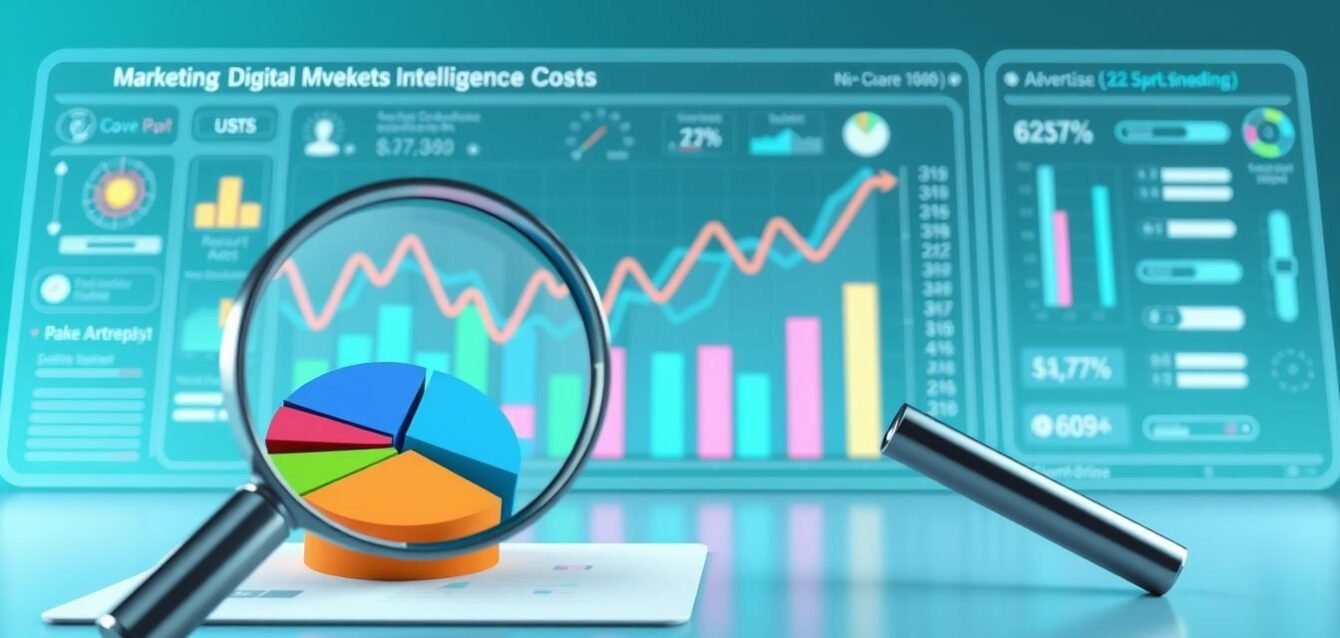Did you know that businesses using AI tools in their campaigns see up to a 300% improvement in ROI? In today’s competitive digital marketing landscape, managing costs while maximizing results is crucial. This is where advanced tools and strategies come into play.
According to PwC’s 2023 survey, companies like Amazon, Starbucks, and Uber are leading the way in using AI to optimize their ad spend. These tools help businesses make smarter decisions, ensuring every dollar counts.
At Macro Webber, we specialize in Performance Marketing That Drives Revenue®. Our approach focuses on reducing costs while boosting your campaign’s effectiveness. Whether you’re running a small business or a large enterprise, understanding how to optimize your digital marketing strategy is key to staying ahead.
In this guide, we’ll show you actionable insights and expert strategies to lower your cost-per-click and improve your ROI. Let’s dive in and explore how you can transform your campaigns with the right tools and techniques.
Key Takeaways
- AI tools can improve ROI by up to 300% in digital marketing campaigns.
- Companies like Amazon and Starbucks use AI to optimize ad spend.
- Macro Webber focuses on performance marketing to drive revenue.
- Understanding cost management is crucial for campaign success.
- Actionable insights can help reduce cost-per-click effectively.
Introduction: Performance Marketing That Drives Revenue®
Modern marketing thrives on data-driven strategies that deliver measurable results. At Macro Webber, we specialize in Performance Marketing That Drives Revenue®. Our approach combines cutting-edge technology with deep industry expertise to help businesses achieve their goals.
About Macro Webber and Our Approach
Macro Webber is a leader in performance marketing, helping businesses optimize their campaigns for maximum impact. We focus on turning data into actionable insights, ensuring every dollar spent delivers value. Our team uses advanced tools and techniques to drive customer engagement and improve ROI.
The evolution of AI in marketing has been a game-changer. From predictive analytics to real-time data integration, these tools allow businesses to connect with their customers in meaningful ways. At Macro Webber, we harness this power to create campaigns that resonate and deliver results.
Overview of the Guide
This guide is designed to help you understand how to optimize your marketing efforts. You’ll learn about the role of analytics in measuring campaign effectiveness and how real-time data can enhance your strategies. Each section provides actionable insights to improve your performance marketing.
Here’s what you can expect:
- An introduction to Macro Webber’s innovative approach.
- Insights into the evolution of AI in marketing.
- Practical tips for integrating analytics into your campaigns.
- Strategies for improving customer engagement and ROI.
Marketing analytics play a crucial role in understanding what works and what doesn’t. By leveraging real-time data, you can make informed decisions that drive better results. At Macro Webber, we’re committed to helping you succeed in today’s competitive landscape.
For more information or to get started, feel free to contact us. We’re here to help you achieve your marketing goals with confidence.
| Key Benefits | How It Helps |
|---|---|
| Data-Driven Strategies | Improves campaign effectiveness and ROI. |
| Real-Time Analytics | Enables quick adjustments for better results. |
| Customer Engagement | Builds stronger connections with your audience. |
Understanding Advertising Intelligence Systems in Digital Marketing
The rise of AI has transformed how businesses approach digital marketing. These advanced systems combine data analysis, machine learning, and predictive modeling to enhance campaign performance. At Macro Webber, we’ve seen firsthand how these tools can revolutionize your strategy.

Definition and Evolution
Advertising intelligence systems are platforms that use AI to analyze and optimize marketing campaigns. Their technical foundations lie in machine learning algorithms and neural networks. These tools process vast amounts of data to provide actionable insights.
The evolution of AI in marketing began with Alan Turing’s groundbreaking work in the 1950s. The Dartmouth Conference in 1956 marked the birth of AI as a field. Since then, advancements in algorithms have paved the way for modern tools that power digital marketing.
Impact on Digital Advertising Efficiency
AI-driven tools improve efficiency by automating repetitive tasks and optimizing ad placements. For example, platforms like Google Ads use machine learning to adjust bids in real time. This ensures your budget is spent where it matters most.
These systems also enhance optimization by analyzing campaign performance across multiple channels. They identify trends and suggest adjustments to improve results. This level of precision was unimaginable just a decade ago.
Here’s how AI tools benefit your marketing strategy:
- Automate tasks like keyword research and ad placement.
- Provide real-time insights for quick decision-making.
- Improve targeting accuracy to reach the right audience.
| Feature | Benefit |
|---|---|
| Real-Time Analytics | Enables immediate campaign adjustments. |
| Predictive Modeling | Forecasts trends for better planning. |
| Automated Bidding | Optimizes ad spend for maximum ROI. |
At Macro Webber, we integrate these tools into your workflow to ensure every campaign delivers results. By leveraging AI, you can stay ahead in today’s competitive digital landscape.
Leveraging Advertising Intelligence Systems to Reduce Cost-Per-Click
Effective ad spend management is crucial for businesses aiming to maximize their marketing ROI. Advanced tools like AI-driven platforms play a key role in achieving this goal. They help reduce CPC by optimizing bids and improving conversion rates.
Automated bid adjustments are one of the most powerful features of these tools. They analyze real-time data to make dynamic decisions, ensuring your budget is spent efficiently. For example, platforms like Google Ads use machine learning to adjust bids based on performance trends.
Tracking your conversion rate is another essential step. It helps you measure the success of your campaigns and identify areas for improvement. By focusing on high-performing ads, you can allocate resources more effectively.
Informed decisions based on AI insights lead to better outcomes. These tools provide actionable data, helping you refine your strategy and improve results. For instance, they can suggest pausing underperforming ads to maintain a high-quality score.
Here’s how these strategies work in practice:
- Automated bidding adjusts bids in real time to maximize ROI.
- Conversion rate tracking identifies the most effective ads.
- AI insights guide decisions to optimize ad spend.
Real-world data is critical for guiding your bid strategies. It ensures your campaigns are aligned with market trends and audience behavior. This approach not only lowers CPC but also boosts overall campaign performance.
| Strategy | Benefit |
|---|---|
| Automated Bidding | Optimizes ad spend for maximum ROI. |
| Conversion Tracking | Identifies high-performing ads for better allocation. |
| AI Insights | Guides decisions to improve campaign outcomes. |
By integrating these strategies, you can achieve significant cost savings while maintaining campaign effectiveness. At Macro Webber, we specialize in helping businesses implement these advanced solutions to drive better results.
Building a Data-Driven Campaign with AI Tools
In today’s fast-paced digital world, data-driven campaigns powered by AI tools are reshaping marketing strategies. These tools help businesses make smarter decisions, ensuring every dollar spent delivers measurable results. At Macro Webber, we specialize in creating campaigns that are not only effective but also cost-efficient.

Utilizing Predictive Analytics for Better Decision Making
Predictive analytics is a game-changer in modern marketing. It uses historical data and machine learning to forecast trends and customer behavior. This allows you to make informed decisions that align with market demands.
For example, AI-powered lead scoring identifies promising customers by analyzing their interactions. This ensures your efforts are focused on high-value prospects. Real-time adjustments based on actions like downloading case studies or visiting pricing pages further enhance accuracy.
Here’s how predictive analytics benefits your campaigns:
- Forecasts trends to guide strategy development.
- Identifies high-value leads for targeted outreach.
- Optimizes resource allocation for maximum ROI.
Real-Time Data Integration in Campaign Strategies
Integrating real-time data into your campaigns ensures they remain dynamic and responsive. AI tools analyze data points like customer behavior and market trends to adjust strategies instantly. This keeps your campaigns relevant and effective.
For instance, dynamic pricing adjusts product prices automatically based on market conditions. Similarly, AI-driven email marketing segments subscribers and customizes content for different audiences. These strategies improve engagement and conversion rates.
Key advantages of real-time data integration include:
- Enables quick adjustments to optimize performance.
- Enhances targeting accuracy for better results.
- Improves customer experience through personalized interactions.
At Macro Webber, we leverage these advanced tools to create campaigns that deliver. Our data-centric approach ensures your marketing efforts are always aligned with your goals. For expert guidance, contact us today and take your campaigns to the next level.
Optimization Techniques for Cost-Effective Advertising
Optimizing your ad campaigns for cost-effectiveness doesn’t have to be a time-consuming challenge. With the right tools and strategies, you can streamline your workflow and maximize results. At Macro Webber, we focus on techniques that save time while improving performance.
Automation of Repetitive Tasks
One of the most effective ways to save time is by automating repetitive tasks. Tools like Google Ads and SEMrush handle keyword research, bid adjustments, and performance tracking automatically. This allows you to focus on strategy rather than manual labor.
Automation also ensures consistency. For example, AI-powered platforms can adjust bids in real time based on performance data. This eliminates guesswork and ensures your budget is spent efficiently.
Adjustment Mechanisms for Efficiency
AI systems excel at making precise adjustments. They analyze data to identify trends and suggest changes that improve results. For instance, if an ad isn’t performing well, the system can pause it and reallocate resources to high-performing campaigns.
These adjustment mechanisms are designed to enhance efficiency. By continuously monitoring performance, they ensure your campaigns remain optimized without constant manual intervention.
The Role of Testing in Refining Ads
Testing is essential for refining ad performance. A/B testing allows you to compare different versions of an ad to see which resonates best with your audience. Tools like SEMrush simplify this process by automating the creation and analysis of test variations.
Regular testing helps you identify what works and what doesn’t. This data-driven approach ensures your ads are always improving, leading to better engagement and lower costs.
At Macro Webber, we believe in the power of smart automation. By leveraging these tools, you can drive both efficiency and effectiveness in your campaigns. Ready to optimize your advertising? Contact us today to get started.
Enhancing Audience Segmentation and Ad Personalization Strategies
Understanding your audience is the cornerstone of successful digital marketing. By refining segmentation and personalization, you can create campaigns that resonate deeply with your customers. At Macro Webber, we specialize in fine-tuning these strategies to maximize engagement and conversions.

Effective Targeting Strategies
Effective targeting begins with identifying the right audience. AI tools analyze data points like demographics, browsing history, and purchase patterns to create detailed profiles. This ensures your ads reach the most relevant users.
For example, platforms like Google Ads and Facebook Ads use machine learning to optimize ad placements. These tools adjust campaigns in real time, ensuring your budget is spent efficiently. By focusing on high-value segments, you can boost engagement and ROI.
Leveraging Behavioral Data
Behavioral data plays a crucial role in ad personalization. AI tracks user actions, such as clicks, page views, and time spent on site, to understand preferences. This data helps create tailored ad experiences that drive conversions.
For instance, dynamic ads adjust content based on user behavior, ensuring relevance. This approach not only improves engagement but also builds stronger connections with your audience.
Here’s how refined segmentation and personalization benefit your campaigns:
- Improved targeting accuracy ensures ads reach the right users.
- Personalized experiences increase engagement and loyalty.
- Higher conversion rates result from relevant and compelling ads.
| Strategy | Benefit |
|---|---|
| AI-Driven Segmentation | Identifies high-value audiences for precise targeting. |
| Behavioral Analysis | Creates personalized ad experiences that resonate. |
| Dynamic Ad Adjustments | Ensures relevance based on real-time user actions. |
At Macro Webber, we integrate these advanced techniques into your campaigns. By leveraging AI insights, you can create a personalized experience that drives measurable results. Ready to transform your marketing strategy? Contact us today to get started.
Streamlining Ad Bidding and Budget Allocation
Streamlining ad bidding and budget allocation is essential for maximizing your marketing ROI. With the right strategies, you can ensure every dollar spent delivers measurable results. At Macro Webber, we specialize in innovative solutions that optimize your campaigns for efficiency and effectiveness.
Dynamic Bid Adjustments with AI
AI-powered tools revolutionize how you manage bids. These platforms analyze real-time data to make dynamic adjustments, ensuring your budget is spent where it matters most. For example, automated bidding systems adjust bids based on performance trends, maximizing conversions while minimizing costs.
Here’s how dynamic bid adjustments work:
- Analyze user behavior and campaign performance in real time.
- Automatically adjust bids to target high-value audiences.
- Optimize budget allocation for maximum ROI.
Role of Performance Metrics and Platforms
Tracking key metrics like CTR and conversion rates is crucial for campaign success. Platforms like Google Ads provide detailed insights into ad performance, helping you make informed decisions. By focusing on these metrics, you can identify underperforming ads and reallocate resources effectively.
Here’s how to allocate your budget efficiently:
- Use platform analytics to identify high-performing campaigns.
- Reallocate funds to ads with the best conversion rates.
- Continuously monitor and adjust based on real-time data.
Case Examples of Successful Bid Management
Many businesses have successfully reduced costs using AI-driven bid strategies. For instance, a retail company used automated bidding to lower CPC by 20% while increasing conversions by 15%. These results highlight the power of integrating AI tools into your workflow.
At Macro Webber, we help you implement these strategies seamlessly. By leveraging user data and advanced platform features, you can achieve cost-effective campaigns that drive results. Ready to optimize your ad bidding? Contact us today to get started.
Measuring Campaign Performance with Advanced Analytics
Measuring campaign performance is essential for achieving your marketing goals. Advanced analytics provide the insights needed to refine your strategies and maximize results. At Macro Webber, we specialize in helping businesses track and analyze key metrics to ensure their campaigns are on the right track.

Key Metrics to Monitor
Tracking the right metrics is crucial for evaluating ad effectiveness. Key indicators like click-through rate (CTR) and conversion rate provide valuable insights into how your audience interacts with your ads. Monitoring these metrics helps you identify trends and make data-driven decisions.
For example, a high CTR indicates your ad messaging resonates with your audience. Similarly, a strong conversion rate shows your sales funnel is working efficiently. By focusing on these metrics, you can optimize your campaigns for better outcomes.
Using Data Reporting Tools
Data reporting tools are essential for gaining actionable insights. Platforms like Google Ads and SEMrush provide detailed analytics that help you understand campaign performance. These tools allow you to track metrics like cost per click (CPC) and return on ad spend (ROAS), ensuring your budget is spent wisely.
A/B testing is another powerful technique. It allows you to compare different ad variations to determine which performs best. By testing elements like headlines, images, and calls-to-action, you can refine your creative strategies and improve results.
Here’s how data reporting tools benefit your campaigns:
- Provide real-time insights for quick adjustments.
- Identify high-performing ads for better resource allocation.
- Enable continuous improvement through testing and analysis.
At Macro Webber, we use advanced analytics to help businesses stay ahead of emerging trends. By monitoring key metrics and leveraging data reporting tools, you can achieve measurable improvements in your campaigns. Ready to optimize your performance? Contact us today to get started.
Integrating AI Tools into Your Marketing Workflow
Integrating AI tools into your marketing workflow can transform how you create and manage campaigns. These tools streamline processes, improve efficiency, and deliver better results. At Macro Webber, we specialize in helping businesses harness the power of AI to optimize their marketing strategies.
Ad Creative Optimization
AI-powered solutions make ad creative optimization faster and more effective. These tools analyze past performance data to suggest improvements for your ad designs. For example, they can recommend better visuals, headlines, or calls-to-action based on what resonates with your audience.
By automating this process, you save time while ensuring your content remains engaging. Platforms like Jasper can even generate copy tailored to your brand’s tone, ensuring consistency across campaigns.
Dynamic Adjustments and A/B Testing
Dynamic adjustments are another key benefit of AI integration. These tools analyze real-time data to tweak your campaigns for better performance. For instance, they can adjust bids, target specific audiences, or pause underperforming ads automatically.
A/B testing is also simplified with AI. Tools like SEMrush allow you to test multiple ad variations simultaneously. This helps you identify the best-performing content and refine your strategies accordingly.
Here’s how AI integration enhances your marketing workflow:
- Automates repetitive tasks, saving time and resources.
- Improves ad relevance through data-driven insights.
- Enhances campaign performance with dynamic adjustments.
| Feature | Benefit |
|---|---|
| Ad Creative Optimization | Ensures engaging and effective content. |
| Dynamic Adjustments | Optimizes campaigns in real time for better results. |
| A/B Testing | Identifies the best-performing ad variations. |
At Macro Webber, we help businesses integrate these tools seamlessly into their workflows. By leveraging AI, you can achieve cost-effective campaigns that drive measurable results. Ready to optimize your marketing strategy? Contact us today to get started.
Ethical Considerations and Challenges in AI Implementation
As AI continues to shape the future of marketing, ethical considerations must take center stage. While these tools offer incredible potential, they also raise important questions about privacy, fairness, and transparency. At Macro Webber, we believe that ethical implementation is not just a responsibility but a cornerstone of sustainable marketing practices.

Data Privacy and Transparency
Protecting datum is a critical concern in AI-driven marketing. With tools analyzing vast amounts of personal information, maintaining privacy is essential. Transparency with customers about how their datum is used builds trust and ensures compliance with regulations like GDPR.
For example, clear privacy policies and opt-in mechanisms empower users to control their information. At Macro Webber, we prioritize these practices to ensure your brand remains trustworthy and compliant.
Addressing Algorithmic Bias
Algorithmic bias can skew results and lead to unfair outcomes. This occurs when the model is trained on incomplete or biased datum. To mitigate this, it’s crucial to use diverse datasets and conduct regular audits.
IBM’s initiatives to identify and reduce bias in advertising serve as a strong example. By adopting similar strategies, you can ensure your campaigns are fair and inclusive.
Here are some best practices for ethical AI implementation:
- Ensure transparency in how datum is collected and used.
- Regularly audit AI tools to identify and address bias.
- Train teams on ethical decision-making alongside technical skills.
| Challenge | Solution |
|---|---|
| Data Privacy | Implement clear policies and user consent mechanisms. |
| Algorithmic Bias | Use diverse datasets and conduct regular audits. |
| Transparency | Communicate openly with customers about data usage. |
By addressing these challenges, you can build a brand that not only performs well but also operates ethically. At Macro Webber, we’re committed to helping you navigate these complexities in a way that aligns with your values and goals.
Case Studies and Real-World Applications of AI in Advertising
AI-powered tools are reshaping the advertising landscape, delivering measurable results across industries. From e-commerce to financial services, businesses are leveraging these technologies to optimize campaigns and achieve significant cost savings. Here, we explore real-world examples and the lessons they offer.
Success Stories from Digital Marketing
One standout example is Amazon, which attributes up to 35% of its total sales to its AI-driven recommendation engine. By analyzing user behavior, Amazon delivers personalized product suggestions, boosting engagement and conversions.
Another success story comes from Netflix, where AI-powered content recommendations account for 80% of the content streamed. This approach not only enhances user experience but also reduces churn rates significantly.
In the financial sector, HubSpot users report up to a 50% increase in qualified leads due to AI-powered lead scoring and nurturing. This demonstrates the role of AI in refining targeting strategies and improving ROI.
Lessons Learned and Best Practices
These case studies highlight the importance of continuous testing and analytics. For instance, Bayer’s Australia team achieved an 85% increase in click-through rates by regularly refining their ad strategies based on real-time data.
Key lessons include:
- Focus on personalization to enhance user engagement.
- Use AI tools for dynamic bid adjustments to optimize amount spent.
- Regularly audit campaigns to identify and address underperforming ads.
Quantitative impacts from these strategies are impressive. For example, AdRoll’s AI-driven platform helped businesses achieve a 2X increase in conversion rates and a 50% reduction in cost per acquisition. These results underscore the action needed to integrate AI into your workflow effectively.
| Company | Improvement |
|---|---|
| Amazon | 35% of sales from AI recommendations |
| Netflix | 80% of content streamed via AI |
| HubSpot | 50% increase in qualified leads |
By adopting these best practices, you can replicate these successes in your campaigns. The role of AI in advertising is undeniable, and its potential to transform your strategy is immense. Start integrating these tools today to see measurable improvements in your results.
Conclusion
AI-driven strategies are transforming how businesses connect with their audiences. Throughout this guide, we’ve explored actionable techniques to optimize campaigns and lower costs. From automated bidding to personalized ad experiences, these methods ensure every dollar spent delivers value.
At Macro Webber, we focus on innovative solutions that drive results. Our approach helps you reach your potential customers more effectively, improving engagement and purchase outcomes. By integrating advanced tools, you can refine your strategies and achieve measurable success.
The future of AI in marketing is bright. As algorithms evolve, they’ll continue to enhance efficiency and reduce costs. Now is the time to embrace these advancements and stay ahead in the competitive landscape.
Ready to transform your campaigns? Contact Macro Webber today to explore how our expertise can help you achieve your goals. Let’s work together to create strategies that deliver real impact.



